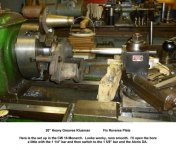Assume I have a manual lathe (Weiler Praktikant VC Plus, german toolroom lathe, 12.6" swing over bed, 11 HP) and I am trying to make the following out of a solid length of steel:
6" O.D. cylinder about 1" long, then reducing to a 2" O.D. cylinder about 4" long
The tricky part is the 2" cylinder portion is not concentric with the 6" portion, it is offset from center with one edge co-incident with the edge of the larger cylinder.
How to make this part? I presume turn the entire length of piece down to 6" O.D., then mount it off center and turn the 2" portion down to size? But I'm concerned this much non-symmetrical metal might be a problem for the lathe? Any suggestions? How best to hold the work piece?
6" O.D. cylinder about 1" long, then reducing to a 2" O.D. cylinder about 4" long
The tricky part is the 2" cylinder portion is not concentric with the 6" portion, it is offset from center with one edge co-incident with the edge of the larger cylinder.
How to make this part? I presume turn the entire length of piece down to 6" O.D., then mount it off center and turn the 2" portion down to size? But I'm concerned this much non-symmetrical metal might be a problem for the lathe? Any suggestions? How best to hold the work piece?



